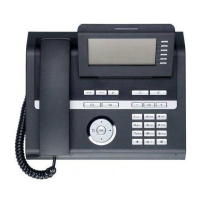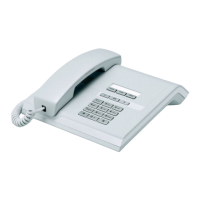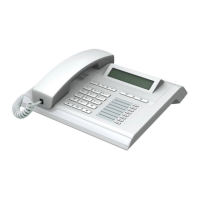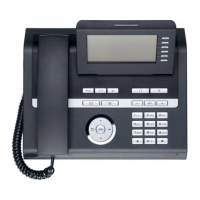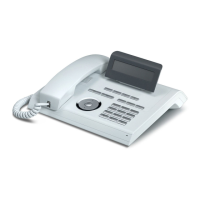Do you have a question about the Unify OpenStage 30 T and is the answer not in the manual?
| Wall Mountable | Yes |
|---|---|
| Display | 2 lines |
| Keys | 8 freely programmable keys |
| Connectivity | TDM |
| Keypad | 12-key |
| Hands-free operation | Yes, full duplex |
| Headset Port | Yes |
| Message Waiting Indicator | Yes |
| Audio | Full-duplex hands-free speakerphone, HD voice |
Provides an overview of the document's content and purpose, including safety instructions and administrative tasks.
Details on how to get help for phone defects, questions regarding operation, or connection issues.
Specifies that the OpenStage phone is designed for speech transmission and should be placed on a desk or wall.
Explains how to find identification details and where to get specific information about the communications platform.
Describes the operating elements and displays of the OpenStage phone, including the handset, display, and keys.
Details the features of the optional key module, which adds 18 illuminated, programmable sensor keys to the phone.
Explains the function, audio, and navigation keys, their purpose, and how they are used to operate the phone.
Covers the eight illuminated keys for assigning functions or numbers, increasing them with a key module.
Describes the phone's idle mode and how to access and navigate the idle menu for various functions.
Explains how the call log stores call attempts and how to access the program/service menu for system functions.
Details the default ring signaling for internal, external, and entrance calls, and how to answer via handset.
Covers procedures for off-hook and on-hook dialing for internal and external calls.
Explains how to call a second party during an ongoing call, placing the first party on hold.
Details variable call forwarding, call forwarding no reply (CFNR), and carrier network forwarding.
Describes how to request a callback when a line is busy or unanswered, and how to store/accept callbacks.
Covers accepting specific calls for colleagues, using the speakerphone, and managing handsfree answerback.
Explains en-bloc sending, using the caller list, internal directory, and LDAP directory for making calls.
Details call waiting functions, including accepting second calls and preventing/allowing automatic camp-on.
Describes how to park calls in slots and retrieve them later, useful for continuing calls at other phones.
Explains how to set up and manage conference calls, adding/removing parties, and leaving/ending conferences.
Covers call waiting (camp-on) and busy override for ensuring connection to called parties.
Guides on assigning frequently used functions, station numbers, or procedures to function keys.
Lists available functions and explains LED status indicators for saved functions and trunk keys.
Details how to save multi-step functions or numbers onto a single key for easier access.
Explains how to program internal and external station numbers on the second level of keys.
Explains how call charges are displayed for the current and last call, and for other telephones (not for U.S.).
Covers assigning external calls to specific projects using account codes for tracking purposes.
Instructions for activating/deactivating ringer cutoff and the 'Do not disturb' function.
Explains how to prevent station number or name from appearing on displays of external parties.
Details on locking the phone to prevent unauthorized use and unlocking it, including PIN management.
Describes how to lock and unlock other telephones remotely to prevent unauthorized access.
Guides on configuring the phone to provide appointment reminders, including saving and using timed reminders.
Covers creating, sending, displaying, and deleting text messages, as well as managing incoming messages.
Instructions for leaving and deleting advisory messages on the phone display for callers.
Explains procedures for changing a phone number and performing a general reset of services and functions.
Details on activating and deactivating various phone functions remotely for other phones.
Covers using system functions remotely via Direct Inward System Access (DISA).
Explains the function of trunk keys as line keys and their LED displays for call status.
Details on placing calls on hold using trunk keys and retrieving them, and making calls on multiple lines.
Describes DSS keys for direct access to team members, including LED messages and answering calls.
Explains how to activate and deactivate call forwarding for trunks and understanding associated LED messages.
Guides on setting audible signaling for calls to the executive phone or a second assigned phone.
Covers activating/deactivating group calls, joining/leaving groups, and understanding audible signals.
Details on setting up ringing groups to signal calls to multiple internal phones and managing them.
Explains how to log on/off shifts, manage work time, and handle night service for call distribution.
Instructions on adjusting the display contrast to suit personal requirements.
Guides on optimizing audio settings for receiving volume, ring volume, and ring tone.
Covers adjusting attention ring volume and speakerphone settings for different room acoustics.
Procedure for selecting the desired language for system functions on the telephone.
Explains how to test the phone's functionality, checking LEDs, display, and ring tone.
Describes how to check which functions are assigned to specific keys on the phone.
Provides causes and reactions for common error messages like 'Invalid entry' or 'Not authorized'.
Offers solutions for issues like keys not responding, phone not ringing, or inability to dial external numbers.
Provides guidelines on cleaning the telephone safely, avoiding damage from chemicals or abrasive agents.
Explains options for labeling keys, either by hand using strips or via an online tool with a computer.

